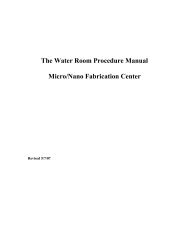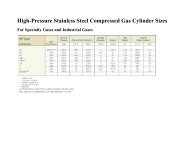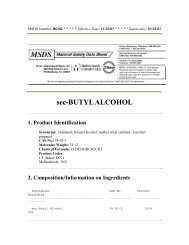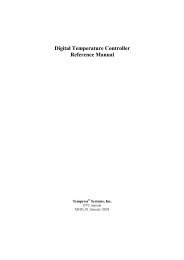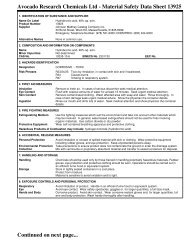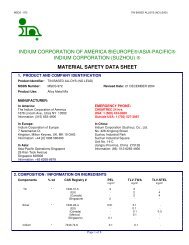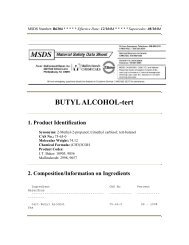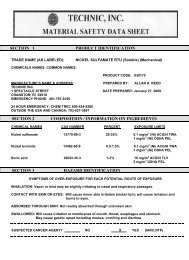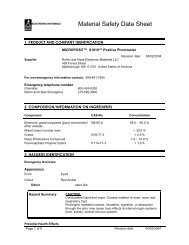Free and Total Chlorine Test Kit • Trousse d'analyse chlore libre et ...
Free and Total Chlorine Test Kit • Trousse d'analyse chlore libre et ...
Free and Total Chlorine Test Kit • Trousse d'analyse chlore libre et ...
Create successful ePaper yourself
Turn your PDF publications into a flip-book with our unique Google optimized e-Paper software.
<strong>•</strong> <strong>Free</strong> <strong>and</strong> <strong>Total</strong> <strong>Chlorine</strong> <strong>Test</strong> <strong>Kit</strong><br />
<strong>•</strong> <strong>Trousse</strong> d’analyse <strong>chlore</strong> <strong>libre</strong> <strong>et</strong> total<br />
<strong>•</strong> <strong>Test</strong> <strong>Kit</strong> auf freies und Gesamtchlor<br />
<strong>•</strong> <strong>Kit</strong> para cloro <strong>libre</strong> y total<br />
0-3.5 mg/L<br />
Mod. CN-66/-66F/-66T<br />
# 2231-01,-02,-03<br />
<strong>•</strong> To ensure accurate results, read carefully before proceeding.<br />
Pour obtenir des résultats exacts, lire attentivement le mode d’emploi avant d’utiliser la trousse.<br />
Um genaue Ergebnisse zu gewährleisten, lesen Sie das Folgende bitte aufmerksam durch, bevor Sie fortfahren.<br />
Para obtener resultados precisos, lea d<strong>et</strong>enidamente las instrucciones antes de proceder al análisis.<br />
WARNING<br />
H<strong>and</strong>ling chemical samples, st<strong>and</strong>ards, <strong>and</strong> reagents can<br />
be dangerous. Review the Material Saf<strong>et</strong>y Data She<strong>et</strong>s<br />
before h<strong>and</strong>ling any chemicals.<br />
ATTENTION<br />
La manipulation des échantillons chimiques, étalons <strong>et</strong><br />
réactifs peut être dangereuse. Lire les fiches de données de<br />
sécurité des produits avant de manipuler tout<br />
produit chimique.<br />
WARNUNG<br />
Die H<strong>and</strong>habung chemischer Proben, St<strong>and</strong>ards und<br />
Reagenzien kann gefährlich sein. Bitte gehen Sie die<br />
Materialsicherheitsdatenblätter durch, bevor Sie<br />
Chemikalien h<strong>and</strong>haben.<br />
2231-88<br />
ADVERTENCIA<br />
El manejo de sustancias químicas, patrones y reactivos,<br />
puede resultar peligroso. Lea las fichas de informaciones<br />
de seguridad de materiales antes de manipular cualquier<br />
producto químico.
Measuring Hints <strong>and</strong> General <strong>Test</strong> Information<br />
<strong>•</strong> Wash all labware b<strong>et</strong>ween tests. Contamination may alter test results. Clean with a nonabrasive<br />
d<strong>et</strong>ergent or a solvent such as isopropyl alcohol. Use a soft cloth for wiping or<br />
drying. Do not use paper towels or tissue on plastic tubes as this may scratch them. Rinse<br />
with clean water (preferably deionized water).<br />
<strong>•</strong> Rinse all viewing tubes thoroughly with the sample water before testing.<br />
<strong>•</strong> To open PermaChem ® Powder Pillows:<br />
1. Tap the bottom of the pillow on a hard surface.<br />
2. Tear open the pillow along the dashed line.<br />
3. Open the pillow <strong>and</strong> form a spout by squeezing the side edges.<br />
4. Pour the contents into the sample.<br />
<strong>•</strong> Accuracy is not affected by undissolved powder.<br />
<strong>•</strong> Read the result of the <strong>Free</strong> <strong>Chlorine</strong> <strong>Test</strong> within one minute of the addition of<br />
the powder.<br />
<strong>•</strong> Read the result of the <strong>Total</strong> <strong>Chlorine</strong> <strong>Test</strong> b<strong>et</strong>ween three <strong>and</strong> six minutes after addition of<br />
the powder.<br />
<strong>•</strong> Hach strongly recommends that, for optimum test results, reagent accuracy be checked<br />
with each new lot of reagents. Use the st<strong>and</strong>ard solution included in this kit or listed in the<br />
OPTIONAL REAGENTS AND EQUIPMENT section. Follow the instructions included<br />
with each st<strong>and</strong>ard solution.<br />
Conseils pour les mesures <strong>et</strong> informations générales sur l’analyse<br />
<strong>•</strong> Laver toute la verrerie entre les analyses. La contamination peut fausser les résultats<br />
d’analyses. Laver avec un détergent non abrasif ou un solvant tel que l’isopropanol.<br />
Utiliser un tissu doux pour essuyer ou sécher. Ne pas utiliser de tissu ou papier d’essuyage<br />
sur les tubes en plastique pour ne pas les rayer. Rincer à l’eau propre<br />
(de préférence de l’eau désionisée).<br />
<strong>•</strong> Rincer soigneusement tous les tubes colorimétriques avec l’échantillon d’eau<br />
avant l’analyse.<br />
<strong>•</strong> Pour ouvrir les sach<strong>et</strong>s PermaChem ® :<br />
1. Taper le bas du sach<strong>et</strong> sur une surface dure.<br />
2. Déchirer le sach<strong>et</strong> en suivant le pointillé.<br />
3. Ouvrir le sach<strong>et</strong> <strong>et</strong> former un bec en rapprochant les bords latéraux.<br />
4. Verser le contenu dans l’échantillon.<br />
<strong>•</strong> L’exactitude n’est pas affectée par la poudre non dissoute.<br />
<strong>•</strong> Lire le résultat de la mesure du <strong>chlore</strong> <strong>libre</strong> en moins d’une minute après l’addition<br />
du réactif.<br />
<strong>•</strong> Lire le résultat de la mesure du <strong>chlore</strong> total entre trois <strong>et</strong> six minutes après l’addition<br />
du réactif.<br />
<strong>•</strong> Pour de meilleurs résultats, Hach recomm<strong>and</strong>e vivement de vérifier la validité du réactif<br />
pour chaque nouveau lot de réactifs. Utiliser la solution étalon contenue dans c<strong>et</strong>te trousse<br />
ou listée dans la partie REACTIFS ET EQUIPEMENTS OPTIONNELS. Suivre les<br />
instructions fournies avec chaque solution étalon.<br />
2
Meßtips und allgemeine <strong>Test</strong>informationen<br />
<strong>•</strong> Waschen Sie alle Laborartikel zwischen den <strong>Test</strong>s. Verunreinigung kann die<br />
<strong>Test</strong>ergebnisse verfälschen. Reinigen Sie sie mit einem nicht scharfen D<strong>et</strong>ergent oder<br />
einem Lösungsmittel wie zum Beispiel Isopropylalkohol. Verwenden Sie für das<br />
Abwischen oder Abtrocknen ein weiches Tuch. Verwenden Sie bei den Plastikröhrchen<br />
keine Papierh<strong>and</strong>tücher oder Tissue-Papier, da dieses sie zerkratzen kann. Spülen Sie mit<br />
sauberem Wasser (vorzugsweise entsalztes Wasser).<br />
<strong>•</strong> Spülen Sie alle Prüfröhrchen vor dem <strong>Test</strong> gründlich mit dem Probenwasser.<br />
<strong>•</strong> Öffnen der PermaChem ® -Pulverkissen:<br />
1. Klopfen Sie mit dem Boden des Kissens auf eine harte Oberfläche.<br />
2. Öffnen Sie das Kissen und bilden Sie durch Drücken der Seitenkanten einen Ausgießer.<br />
3. Schütten Sie den Inhalt in die Probe.<br />
<strong>•</strong> Die Genauigkeit wird durch unaufgelöstes Pulver nicht beeinträchtigt.<br />
<strong>•</strong> Lesen Sie das Ergebnis des <strong>Test</strong>s auf freies Chlor innerhalb von 1 Minute nach der Zugabe<br />
des Pulvers ab.<br />
<strong>•</strong> Lesen Sie das Ergebnis des Gesamtchlor-<strong>Test</strong>s zwischen drei und sechs Minuten nach der<br />
Zugabe des Pulvers ab.<br />
<strong>•</strong> Hach empfiehlt dringend, für optimale <strong>Test</strong>ergebnisse die Genauigkeit des Reagenzes bei<br />
jeder neuen Charge von Reagenzien zu überprüfen. Verwenden Sie dazu die diesem <strong>Kit</strong><br />
beiliegende St<strong>and</strong>ardlösung oder die im Abschnitt ZUSÄTZLICHE REAGENZIEN UND<br />
ZUBEHÖR aufgeführte St<strong>and</strong>ardlösung. Befolgen Sie die Anweisungen, die jeder<br />
St<strong>and</strong>ardlösung beiliegen.<br />
Consejos para la medición e información general sobre el análisis<br />
<strong>•</strong> Lavar todo el material de laboratorio entre los análisis. La contaminación puede alterar los<br />
resultados. Limpiar con d<strong>et</strong>ergentes no abrasivos o con un disolvente como el alcohol<br />
isopropílico. Utilizar un paño suave para limpiar o secar. No utilizar ni toallitas ni<br />
pañuelos de papel para limpiar los tubos de plastico para no rayarlos. Aclarar con agua<br />
limpia (preferentemente agua desionizada).<br />
<strong>•</strong> Enjuagar todos los tubos para colorim<strong>et</strong>ría abundantemente con la muestra de agua antes<br />
de realizar el análisis.<br />
<strong>•</strong> Para abrir las Cápsulas de Reactivo PermaChem ® proceda del siguiente modo:<br />
1. Golpee ligeramente la parte inferior de la cápsula contra una superficie dura.<br />
2. Tire de la línea de puntos para abrir.<br />
3. Abra la cápsula y presione sobre los laterales de la misma hasta que se forme un pico.<br />
4. Vierta el contenido en la muestra.<br />
<strong>•</strong> La exactitud del análisis no se verá afectada por restos de polvos de reactivo sin disolver.<br />
<strong>•</strong> No deje transcurrir más de un minuto entre la adición de los polvos de reactivo y la lectura<br />
del resultado de la d<strong>et</strong>erminación de cloro <strong>libre</strong>.<br />
<strong>•</strong> Lea el resultado de la d<strong>et</strong>erminación de cloro <strong>libre</strong> entre un minuto, después de haber<br />
añadido los polvos de reactivo.<br />
<strong>•</strong> Lea el resultado de la d<strong>et</strong>erminación de cloro total entre tres y seis minutos, después de<br />
haber añadido los polvos de reactivo.<br />
<strong>•</strong> Para obtener mejores resultados, Hach recomienda encarecidamente comprobar la validez<br />
del reactivo con cada nuevo lote. Utilice para ello la solución patrón incluida en este kit o<br />
relacionada en la sección de REACTIVOS Y EQUIPAMIENTO OPCIONALES. Siga las<br />
instrucciones que se incluyen en cada solución patrón.<br />
3
<strong>•</strong> <strong>Free</strong> <strong>Chlorine</strong> <strong>Test</strong> <strong>•</strong> Technique <strong>chlore</strong> <strong>libre</strong><br />
<strong>•</strong> <strong>Test</strong> Auf Freies Chlor <strong>•</strong> D<strong>et</strong>erminación de cloro <strong>libre</strong><br />
1. Fill a viewing tube to the first (5-mL) line with sample<br />
water. This is the blank.<br />
<strong>•</strong> Remplir un tube colorimétrique jusqu’au premier trait<br />
(5-mL) avec l’échantillon d’eau. Ceci est le blanc.<br />
<strong>•</strong> Füllen Sie ein Prüfröhrchen bis zur ersten (5-mL) Linie<br />
mit Probenwasser. Dieses ist die Blindprobe.<br />
<strong>•</strong> Llene un tubo para colorim<strong>et</strong>ría hasta la primera marca<br />
(5-mL) con la muestra de agua. Esto constituye el blanco.<br />
2. Place this tube in the top left opening of the<br />
color comparator.<br />
<strong>•</strong> Placer ce tube dans l’ouverture supérieure gauche<br />
du comparateur.<br />
<strong>•</strong> Stellen Sie dieses Röhrchen in die obere linke Öffnung<br />
des Farbkomparators.<br />
<strong>•</strong> Coloque este tubo en la abertura superior izquierda<br />
del comparador.<br />
3. Fill another viewing tube to the first (5-mL) line with<br />
sample water.<br />
<strong>•</strong> Remplir un autre tube jusqu’au premier trait (5-mL) avec<br />
l’échantillon d’eau.<br />
<strong>•</strong> Füllen Sie ein weiteres Prüfröhrchen bis zur ersten<br />
(5-mL) Linie mit Probenwasser.<br />
<strong>•</strong> Llene otro tubo para colorim<strong>et</strong>ría hasta la primera marca<br />
(5-mL) con la muestra de agua.<br />
4
4. Add the contents of one DPD <strong>Free</strong> <strong>Chlorine</strong> Reagent<br />
Powder Pillow to the second tube. Compl<strong>et</strong>e the test <strong>and</strong><br />
read the result within one minute of the addition of<br />
the powder.<br />
<strong>•</strong> Ajouter le contenu d’un sach<strong>et</strong> de réactif DPD <strong>chlore</strong> <strong>libre</strong><br />
au second tube. Terminer l’essai <strong>et</strong> lire le résultat en<br />
moins d’une minute après l’addition du réactif.<br />
<strong>•</strong> Geben Sie den Inhalt eines DPD-freien Chlorreagenz-<br />
Pulverkissens in das zweite Röhrchen. Beenden Sie den<br />
<strong>Test</strong> und lesen Sie das Ergebnis innerhalb von einer<br />
Minute nach der Zugabe des Pulvers ab.<br />
<strong>•</strong> Vierta el contenido de una de las cápsulas de reactivo de<br />
cloro <strong>libre</strong> DPD en el segundo tubo de los preparados<br />
anteriormente. Realice el análisis y lea el resultado en el<br />
curso de un minuto tras la adición del polvo de reactivo.<br />
5. Swirl to mix.<br />
<strong>•</strong> Agiter pour mélanger.<br />
<strong>•</strong> Schwenken Sie zum Vermischen.<br />
<strong>•</strong> Agite para mezclar.<br />
6. Place the second tube in the top right opening of the<br />
color comparator.<br />
<strong>•</strong> Placer le second tube dans l’ouverture supérieure droite<br />
du comparateur.<br />
<strong>•</strong> S<strong>et</strong>zen Sie das zweite Röhrchen in die obere rechte<br />
Öffnung des Farbkomparators.<br />
<strong>•</strong> Coloque el segundo tubo en la abertura superior derecha<br />
del comparador.<br />
5
7. Hold comparator up to a light source such as the sky, a<br />
window or a lamp. Look through the openings in front.<br />
<strong>•</strong> Tenir le comparateur face à une surface uniformément<br />
éclairée (ciel, lampe, fenêtre) <strong>et</strong> regarder par les<br />
ouvertures de la face antérieure du comparateur.<br />
<strong>•</strong> Halten Sie den Komparator gegen eine Lichtquelle, wie<br />
zum Beispiel den Himmel, ein Fenster oder eine Lampe.<br />
Sehen Sie durch die Öffnungen vorn.<br />
<strong>•</strong> Oriente el comparador hacia una fuente de luz, tal como el<br />
cielo, una ventana o una lámpara. Mire a través de las<br />
aberturas frontales del comparador.<br />
8. Rotate the color disc until the color matches in the<br />
two openings.<br />
<strong>•</strong> Tourner le disque jusqu’à égalité des teintes dans les<br />
deux ouvertures.<br />
<strong>•</strong> Drehen Sie die Farbscheibe, bis die Farbe in den beiden<br />
Öffnungen übereinstimmt.<br />
<strong>•</strong> Haga girar el disco de color hasta que el color coincida en<br />
ambas aberturas.<br />
9. Read the mg/L free chlorine in the scale window.<br />
<strong>•</strong> Lire la concentration du <strong>chlore</strong> <strong>libre</strong> en mg/L dans la<br />
fenêtre de l’échelle.<br />
<strong>•</strong> Lesen Sie die mg/L freies Chlor in dem Skalenfenster ab.<br />
<strong>•</strong> Lea los mg/L de cloro <strong>libre</strong> en la ventanilla de la escala.<br />
6
<strong>•</strong> <strong>Total</strong> <strong>Chlorine</strong> <strong>Test</strong> <strong>•</strong> Technique <strong>chlore</strong> total<br />
<strong>•</strong> Gesamtchlor-<strong>Test</strong> <strong>•</strong> D<strong>et</strong>erminación de cloro total<br />
1. Fill a viewing tube to first (5-mL) line with sample water.<br />
This is the blank.<br />
<strong>•</strong> Remplir un tube colorimétrique jusqu’au premier trait<br />
(5-mL) avec l’échantillon d’eau. Ceci est le blanc.<br />
<strong>•</strong> Füllen Sie ein Prüfröhrchen bis zur ersten (5-mL) Linie<br />
mit Probenwasser. Dieses ist die Blindprobe.<br />
<strong>•</strong> Llene un tubo para colorim<strong>et</strong>ría hasta la primera marca<br />
(5-mL) con la muestra de agua. Esto constituye el blanco.<br />
2. Place this tube in the top left opening of the<br />
color comparator.<br />
<strong>•</strong> Placer ce tube dans l’ouverture supérieure gauche<br />
du comparateur.<br />
<strong>•</strong> Stellen Sie dieses Röhrchen in die obere linke Öffnung<br />
des Farbkomparators.<br />
<strong>•</strong> Coloque este tubo en la abertura superior izquierda<br />
del comparador.<br />
3. Fill another viewing tube to the first (5-mL) line with<br />
sample water.<br />
<strong>•</strong> Remplir un autre tube jusqu’au premier trait (5-mL) avec<br />
l’échantillon d’eau.<br />
<strong>•</strong> Füllen Sie ein weiteres Prüfröhrchen bis zur ersten<br />
(5-mL) Linie mit Probenwasser.<br />
<strong>•</strong> Llene otro tubo para colorim<strong>et</strong>ría hasta la primera marca<br />
(5-mL) con la muestra de agua.<br />
7
4. Add the contents of one DPD <strong>Total</strong> <strong>Chlorine</strong> Reagent<br />
Powder Pillow to the second tube.<br />
<strong>•</strong> Ajouter le contenu d’un sach<strong>et</strong> de réactif DPD <strong>chlore</strong> total<br />
au second tube.<br />
<strong>•</strong> Geben Sie den Inhalt eines DPD-Gesamtchlorreagenz-<br />
Pulverkissens in das zweite Röhrchen.<br />
<strong>•</strong> Vierta el contenido de una de las Cápsulas de Reactivo de<br />
Cloro <strong>Total</strong> DPD en el segundo tubo de los<br />
preparados anteriormente.<br />
5. Swirl to mix. Wait three minutes. The result of the test must<br />
be read within six minutes of the addition of the powder.<br />
<strong>•</strong> Agiter pour mélanger. Attendre trois minutes. Lire le<br />
résultat en moins de six minutes après l’addition du réactif.<br />
<strong>•</strong> Schwenken Sie es zum Vermischen. Warten Sie drei<br />
Minuten lang. Das <strong>Test</strong>ergebnis muß innerhalb von sechs<br />
Minuten nach der Zugabe des Pulvers abgelesen werden.<br />
<strong>•</strong> Agite hasta mezclar. Espere tres minutos. El resultado del<br />
análisis debe leerse antes de transcurridos seis minutos<br />
desde la adición del polvo de reactivo.<br />
6. Place the second tube in the top right opening of the<br />
color comparator.<br />
<strong>•</strong> Placer le second tube dans l’ouverture supérieure droite<br />
du comparateur.<br />
<strong>•</strong> Stellen Sie das zweite Röhrchen in die obere rechte<br />
Öffnung des Farbkomparators.<br />
<strong>•</strong> Coloque el segundo tubo en la abertura superior derecha<br />
del comparador de colores.<br />
8
7. Hold comparator up to a light source such as the sky, a<br />
window or a lamp. Look through the openings in front.<br />
<strong>•</strong> Tenir le comparateur face à une surface uniformément<br />
éclairée (ciel, lampe, fenêtre) <strong>et</strong> regarder par les<br />
ouvertures de la face antérieure du comparateur.<br />
<strong>•</strong> Halten Sie den Komparator gegen eine Lichtquelle, wie<br />
zum Beispiel den Himmel, ein Fenster oder eine Lampe.<br />
Sehen Sie durch die Öffnungen vorn.<br />
<strong>•</strong> Oriente el comparador hacia una fuente de luz, tal como el<br />
cielo, una ventana o una lámpara. Mire a través de las<br />
aberturas frontales del comparador.<br />
8. Rotate the color disc until the color matches in the<br />
two openings.<br />
<strong>•</strong> Tourner le disque jusqu’à égalité des teintes dans les<br />
deux ouvertures.<br />
<strong>•</strong> Drehen Sie die Farbscheibe, bis die Farbe in den beiden<br />
Öffnungen übereinstimmt.<br />
<strong>•</strong> Haga girar el disco de color hasta que el color coincida en<br />
ambas aberturas.<br />
9. Read the mg/L total chlorine in the scale window.<br />
<strong>•</strong> Lire la concentration du <strong>chlore</strong> total en mg/L dans la<br />
fenêtre de l’échelle.<br />
<strong>•</strong> Lesen Sie die mg/L Gesamtchlor im Skalenfenster ab.<br />
<strong>•</strong> Lea los mg/L de cloro total en la ventanilla de la escala.<br />
9
REPLACEMENTS<br />
Description Unit Cat. No.<br />
Color Comparator Box ............................................................................ each.........1732-00<br />
Color Disc, DPD <strong>Chlorine</strong>, 0–3.5 mg/L.................................................. each.......21988-00<br />
Color Viewing Tube, plastic, with cap .................................................. 4/pkg.......46600-04<br />
DPD <strong>Free</strong> <strong>Chlorine</strong> Reagent Powder Pillows ................................... 100/pkg.......14077-99<br />
DPD <strong>Total</strong> <strong>Chlorine</strong> Reagent Powder Pillows .................................. 100/pkg.......14076-99<br />
REACTIFS ET PIECES DE RECHANGE<br />
Désignation Unité Réf. N o<br />
Comparateur ................................................................................................. 1.........1732-00<br />
Disque coloré <strong>chlore</strong> DPD, 0–3,5 mg/L....................................................... 1.......21988-00<br />
Tube colorimétrique en plastique avec bouchon....................................4/paq.......46600-04<br />
Réactif DPD <strong>chlore</strong> <strong>libre</strong>, 5 mL .........................................................100/paq.......14077-99<br />
Réactif DPD <strong>chlore</strong> total, 5 mL..........................................................100/paq.......14076-99<br />
VERBRAUCHSMATERIAL UND ERSATZTEILE<br />
Beschreibung Einheit Kat. Nr.<br />
Farbkomparator ............................................................................................ 1.........1732-00<br />
Farbscheibe, DPD-Chlor, 0–3,5 mg/L.......................................................... 1.......21988-00<br />
Farbprüfröhrchen, Plastik, mit Kappe .................................................. 4/Stck.......46600-04<br />
DPD freies Chlorreagenz-Pulverkissen............................................ 100/Stck.......14077-99<br />
DPD Gesamtchlorreagenz-Pulverkissen .......................................... 100/Stck.......14076-99<br />
REACTIVOS Y MATERIALES<br />
Descripción Unidad N o Ref.<br />
Comparador de Colores................................................................................ 1.........1732-00<br />
Disco de Color Cloro DPD, 0–3.5 mg/L...................................................... 1.......21988-00<br />
Tubo Para Colorim<strong>et</strong>ría de plástico, con tapa protectora ...................... 4/lote.......46600-04<br />
Cápsulas de Reactivo de Cloro Libre DPD....................................... 100/lote.......14077-99<br />
Cápsulas de Reactivo de Cloro <strong>Total</strong> DPD ....................................... 100/lote.......14076-99<br />
10
OPTIONAL REAGENTS AND EQUIPMENT<br />
Description Unit Cat. No.<br />
Caps, for plastic Color Viewing Tubes 46600-04 ................................. 4/pkg.......46600-14<br />
<strong>Chlorine</strong> St<strong>and</strong>ard Solution, 50–75 mg/L, 2-mL PourRite Ampule.... 20/pkg.......14268-20<br />
Color Viewing Tube, glass .................................................................... 6/pkg.........1730-06<br />
Instructions, Color Viewing Tube ........................................................... each.......46600-88<br />
Stoppers, for glass Color Viewing Tubes 1730-06................................ 6/pkg.........1731-06<br />
REACTIFS ET EQUIPEMENTS OPTIONNELS<br />
Désignation Unité Réf. N o<br />
Bouchons pour tubes en plastique 46600-04..........................................4/paq.......46600-14<br />
Solution étalon <strong>chlore</strong>, 50–75 mg/L, ampoule PourRite 2 mL ............20/paq.......14268-20<br />
Tube colorimétrique en verre .................................................................6/paq.........1730-06<br />
Instructions pour tubes colorimétriques ....................................................... 1.......46600-88<br />
Bouchons pour tubes en verre 1730-06..................................................6/paq.........1731-06<br />
ZUSÄTZLICHE REAGENZIEN UND ZUBEHÖR<br />
Beschreibung Einheit Kat. Nr.<br />
Kappe für Plastik-Prüfröhrchen 46600-04 ........................................... 4/Stck.......46600-14<br />
Chlorst<strong>and</strong>ardlösung, 50–75 mg/L, 2 mL-PourRite-Ampulle ........... 20/Stck.......14268-20<br />
Prüfröhrchen, Glas ............................................................................... 6/Stck.........1730-06<br />
Gebrauchsanweisung für Farbprüfröhrchen................................................. 1.......46600-88<br />
Stopfen für Glas-Prüfröhrchen 1730-06............................................... 6/Stck.........1731-06<br />
REACTIVOS Y EQUIPAMIENTO OPCIONALES<br />
Descripción Unidad N o Ref.<br />
Tapones para tubos de plástico 46600-04.............................................. 4/lote.......46600-14<br />
Solución patrón de cloro, 50–75 mg/L ampollas PourRite de 2 mL... 20/lote.......14268-20<br />
Tubos para colorim<strong>et</strong>ría de vidrio ......................................................... 6/lote.........1730-06<br />
Instrucciones para los tubos para colorim<strong>et</strong>ría............................................. 1.......46600-88<br />
Tapones para tubos de vidrio 1730-06 .................................................. 6/lote.........1731-06<br />
11
<strong>•</strong> Pour assistance technique, informations de prix ou informations pour<br />
comm<strong>and</strong>er, contactez HACH Company ou votre distributeur HACH.<br />
<strong>•</strong> Technische Unterstützung, aktuelle Preisauskünfte und Bestellhilfe<br />
erhalten Sie bei Ihrer HACH Vertr<strong>et</strong>ung.<br />
<strong>•</strong> Para obtener asistencia técnica asi como información sobre los precios y<br />
pedidos, ponerse en contacto con HACH Company o la agencia local<br />
de distribución.<br />
© Hach Company, 1997. All rights reserved. Printed in the U.S.A. te/dk 12/96-1ED



